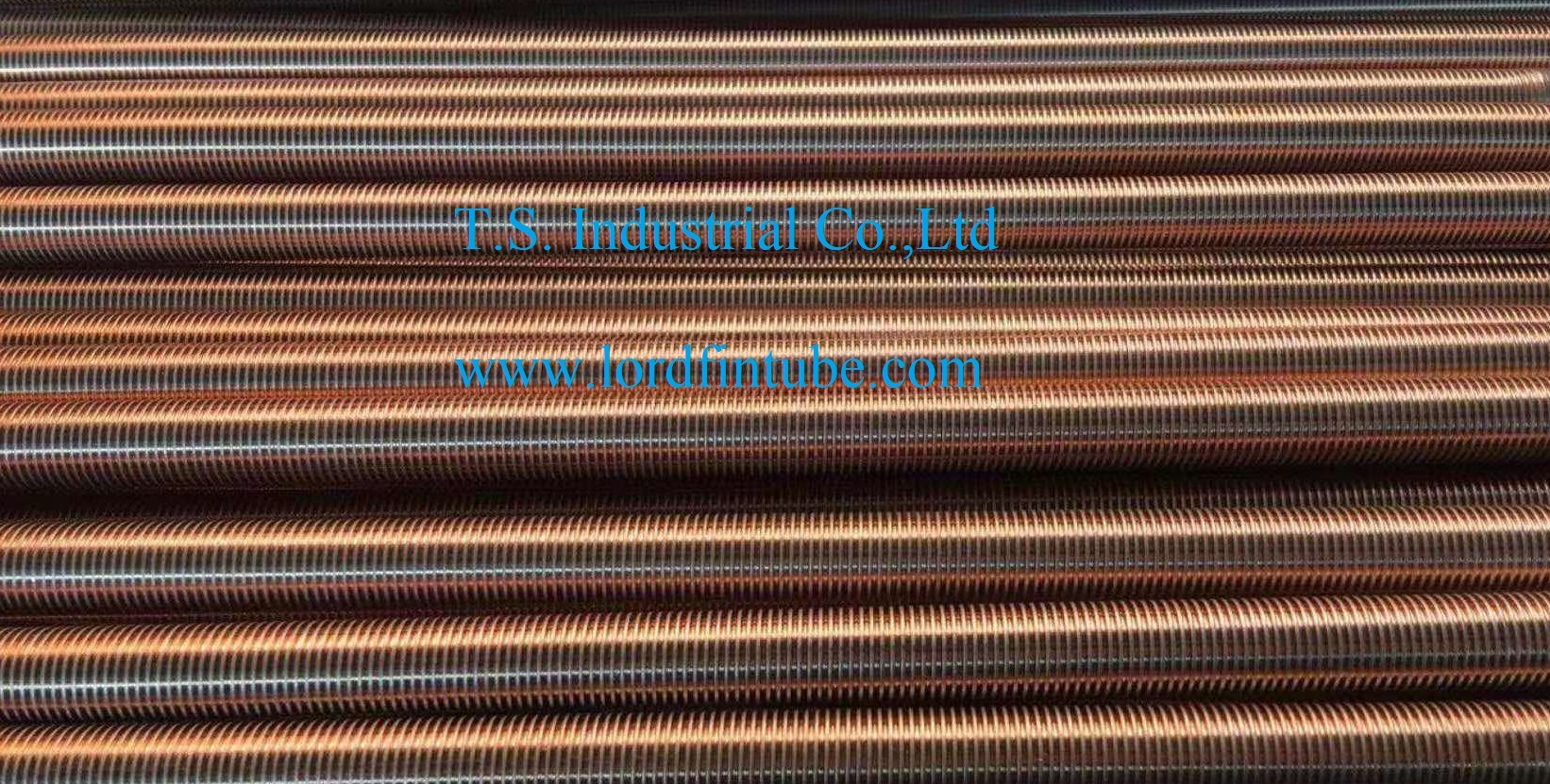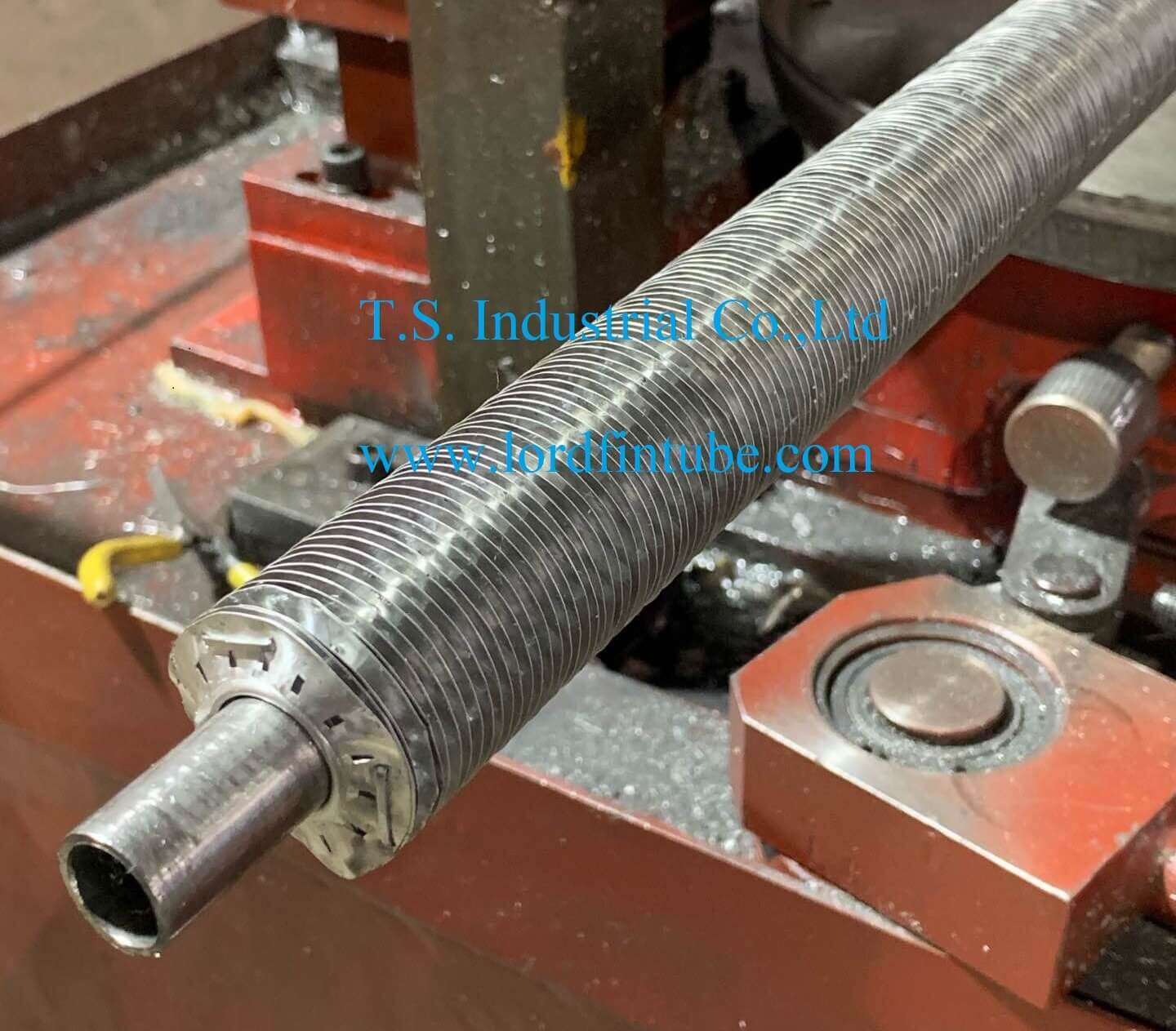NOTICIAS
Lord Fin Tube-Espaciado de aletas del intercambiador de calor de tubos con aletas
In General, the spacing and fin height of the finned tube heat exchanger mainly affect the fining ratio, which has a great relationship with the film heat transfer coefficient of the medium inside and outside the tube. If the difference in heat transfer coefficient between the inside and outside of the tube is large, a finned tube with a relatively large fining ratio should be selected, such as steam heating air. When there is a phase change on one side of the medium, the difference in heat transfer coefficient will be greater, such as the exchange of cold and hot air. When the hot air drops below the dew point, a finned tube heat exchanger can be used. In the case of air-to-air heat exchange without phase change, or water-to-water heat exchange, bare tubes are usually more suitable. Of course, low-fin tubes can also be used, because this is a weak heat-supply coefficient, and strengthening either side has a certain effect. However, the effect of an excessively large fining ratio is not obvious. The best internal and external contact area of the tube is strengthened at the same time, and a threaded tube or a fluted tube can be used.
The pitch of the fins mainly considers factors such as dust accumulation, dust formation, and easy cleaning. At the same time, it must strictly meet the requirements of the equipment for pressure drop. When arranging, the distance between the tube and the tube is not easy to be too large, generally more than 1mm is suitable for laying the tube. In the process of heat exchange, when the air flows through the finned tube heat exchanger, the two sides of the fin are mainly involved in the heat exchange. There is only a small amount of radiant heat transfer in the middle of the two finned tubes, and the heat transfer effect is not obvious.
Since this part has no fins and no resistance, the air easily penetrates. In the process of air heating, the cold air without heat exchange will form a neutralization with the heated hot air passing through the middle of the fins, but instead reduces the effect of heat exchange. Compared with foreign finned tube heat exchangers, tubes The spacing is only 0.5mm larger than the outer diameter of the fins, which shows the importance of the spacing of the tubes when the finned tubes are arranged.
The tube arrangement of the finned tube heat exchanger should be arranged as regular triangles as possible. The hot air passing through the first row encounters resistance in the second row, and there is a certain rebound wind, so that there is no dead angle in the 360 ° heat transfer of the entire finned tube. Therefore, the arrangement of isosceles triangles should be avoided, and square arrangements should not be used, unless there are special requirements.
The pressure drop on the air side is a very important parameter in the design, which has a great relationship with the arrangement of the finned tube. When the design of the finned tube is arranged, the ratio of the narrow-gap flow surface to the windward surface should be calculated, so that it can be calculated according to the wind speed The air mass flow rate is obtained, and the coefficient of friction is calculated for the dynamic viscosity of air with different degrees.

El control de la separación entre tubos y la separación entre placas del intercambiador de calor de tubos con aletas
En circunstancias normales, la separación y la altura de la aleta del intercambiador de calor del tubo con aletas afectan principalmente la relación de aleteo, que tiene una gran relación con el coeficiente de transferencia de calor de la película del medio dentro y fuera del tubo. Si la diferencia en el coeficiente de transferencia de calor entre el interior y el exterior del tubo es grande, se debe seleccionar un tubo con aletas con una relación de clarificación relativamente grande, como el aire de calentamiento por vapor. Cuando hay un cambio de fase en un lado del medio, la diferencia en el coeficiente de transferencia de calor será mayor, como el intercambio de aire frío y caliente. Cuando el aire caliente cae por debajo del punto de rocío, se puede usar un intercambiador de calor de tubo con aletas. En el caso del intercambio de calor aire-aire sin cambio de fase, o intercambio de calor agua-agua, los tubos desnudos suelen ser más adecuados. Por supuesto, también se pueden usar tubos de aleta baja, porque este es un coeficiente de suministro de calor débil, y el fortalecimiento de ambos lados tiene un cierto efecto. Sin embargo, el efecto de una relación de aleteo excesivamente grande no es obvio: la mejor área de contacto interna y externa del tubo se fortalece al mismo tiempo, y se puede usar un tubo roscado o un tubo acanalado.
La inclinación de las aletas considera principalmente factores como la acumulación de polvo, la formación de polvo y la fácil limpieza, al mismo tiempo, debe cumplir estrictamente con los requisitos del equipo para la caída de presión. Cuando se organiza, la distancia entre el tubo y el tubo no es fácil de ser demasiado grande, generalmente más de 1 mm es adecuado para colocar el tubo. En el proceso de intercambio de calor, cuando el aire fluye a través del intercambiador de calor de tubo con aletas, los dos lados de la aleta participan principalmente en el intercambio de calor. Solo hay una pequeña cantidad de transferencia de calor radiante en el medio de los dos tubos con aletas, y el efecto de transferencia de calor no es obvio.
Como esta parte no tiene aletas ni resistencia, el aire penetra fácilmente. En el proceso de calentamiento del aire, el aire frío sin intercambio de calor formará una neutralización con el aire caliente calentado que pasa por el medio de las aletas, pero en cambio reduce el efecto del intercambio de calor. El espacio es solo 0,5 mm más grande que el diámetro exterior de las aletas, lo que muestra la importancia del espacio de los tubos cuando los tubos con aletas están dispuestos.
La disposición de los tubos del intercambiador de calor de tubos con aletas debe disponerse de la forma más triangular posible. Después de pasar por la primera fila, el aire caliente encuentra resistencia en la segunda fila, y hay un cierto viento de rebote, por lo que no hay ángulo muerto en la transferencia de calor de 360 ° de todo el tubo con aletas. Por lo tanto, debe evitar la disposición del triángulo isósceles, trate de no utilizar la disposición cuadrada, a menos que haya requisitos especiales.
La caída de presión en el lado del aire es un parámetro muy importante en el diseño, que tiene una gran relación con la disposición del tubo con aletas. Cuando se organiza el diseño del tubo con aletas, se debe calcular la relación entre la superficie de flujo de espacio estrecho y la superficie de barlovento, de modo que pueda calcularse de acuerdo con la velocidad del viento Se obtiene el caudal másico de aire y se calcula el coeficiente de fricción para la viscosidad dinámica del aire con diferentes grados.
Die Kontrolle des Rohrabstands und des Plattenabstands des Rippenrohrwärmetauschers
Unter normalen Umständen beeinflussen der Abstand und die Rippenhöhe des Rippenrohrwärmetauschers hauptsächlich das Rippenverhältnis, das eine große Beziehung zum Filmwärmeübertragungskoeffizienten des Mediums innerhalb und außerhalb des Rohrs hat. Wenn der Unterschied im Wärmeübergangskoeffizienten zwischen der Innenseite und der Außenseite des Rohrs groß ist, sollte ein Rippenrohr mit einem relativ großen Schönungsverhältnis ausgewählt werden, z. B. Dampfheizluft. Wenn auf einer Seite des Mediums eine Phasenänderung auftritt, ist der Unterschied im Wärmeübertragungskoeffizienten größer, z. B. beim Austausch von kalter und heißer Luft. Wenn die heiße Luft unter den Taupunkt fällt, kann ein Rippenrohrwärmetauscher verwendet werden. Im Falle eines Luft-Luft-Wärmeaustauschs ohne Phasenwechsel oder eines Wasser-Wasser-Wärmeaustauschs sind blanke Rohre normalerweise besser geeignet. Natürlich können auch Rohre mit niedriger Rippe verwendet werden, da dies ein schwacher Wärmezufuhrkoeffizient ist und eine Verstärkung auf beiden Seiten einen gewissen Effekt hat. Der Effekt eines übermäßig großen Schönungsverhältnisses ist jedoch nicht offensichtlich. Die beste innere und äußere Kontaktfläche des Rohrs wird gleichzeitig verstärkt, und es kann ein Gewinderohr oder ein geriffeltes Rohr verwendet werden.
Die Steigung der Lamellen berücksichtigt hauptsächlich Faktoren wie Staubansammlung, Staubbildung und einfache Reinigung. Gleichzeitig muss sie die Anforderungen der Ausrüstung für den Druckabfall genau erfüllen. Bei der Anordnung ist der Abstand zwischen dem Rohr und dem Rohr nicht leicht zu groß, im Allgemeinen sind mehr als 1 mm zum Verlegen des Rohrs geeignet. Wenn beim Luftaustausch die Luft durch den Rippenrohrwärmetauscher strömt, sind hauptsächlich die beiden Seiten der Rippe am Wärmeaustausch beteiligt. In der Mitte der beiden Rippenrohre tritt nur eine geringe Strahlungswärmeübertragung auf, und der Wärmeübertragungseffekt ist nicht offensichtlich.
Da dieser Teil keine Rippen und keinen Widerstand hat, dringt die Luft leicht ein. Beim Erhitzen der Luft bildet die kalte Luft ohne Wärmeaustausch eine Neutralisation, wobei die erwärmte heiße Luft durch die Mitte der Rippen strömt, verringert jedoch stattdessen den Effekt des Wärmeaustauschs. Im Vergleich zu Fremdrippenrohrwärmetauschern sind Rohre Der Abstand ist nur 0,5 mm größer als der Außendurchmesser der Rippen, was die Bedeutung des Abstands der Rohre bei der Anordnung der Rippenrohre zeigt.
Die Rohranordnung des Rippenrohrwärmetauschers sollte so regelmäßig wie möglich angeordnet sein. Nach dem Durchgang durch die erste Reihe stößt die heiße Luft in der zweiten Reihe auf Widerstand, und es gibt einen gewissen Rückprallwind, so dass bei der 360 ° -Wärmeübertragung des gesamten Rippenrohrs kein Totwinkel auftritt. Um eine gleichschenklige Dreiecksanordnung zu vermeiden, versuchen Sie daher, keine quadratische Anordnung zu verwenden, es sei denn, es gibt besondere Anforderungen.
Der Druckabfall auf der Luftseite ist ein sehr wichtiger Parameter bei der Konstruktion, der einen großen Zusammenhang mit der Anordnung des Rippenrohrs hat. Wenn die Konstruktion des Rippenrohrs angeordnet ist, sollte das Verhältnis der Strömungsfläche mit schmalem Spalt zur Luvoberfläche berechnet werden, damit es anhand der Windgeschwindigkeit berechnet wird Der Luftmassenstrom wird erhalten und der Reibungskoeffizient für die dynamische Viskosität von Luft mit unterschiedlichen Graden berechnet.
请输入搜索关键字
确定






